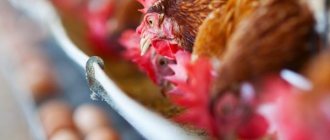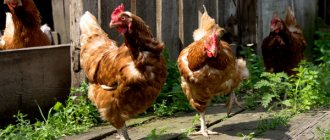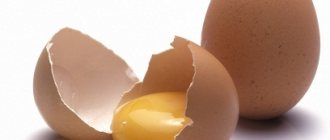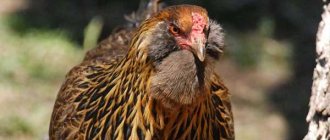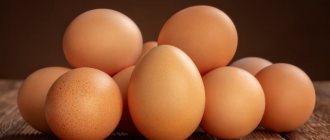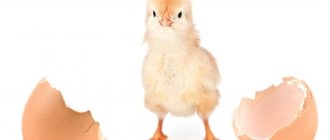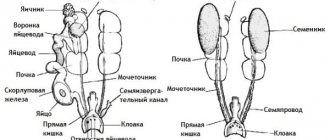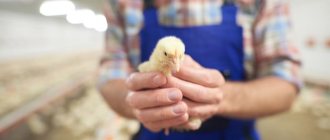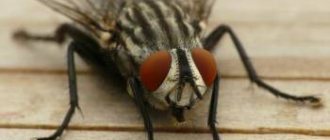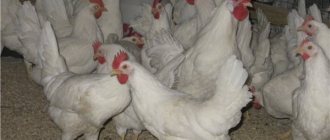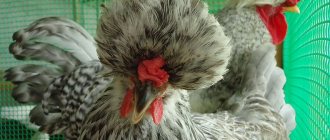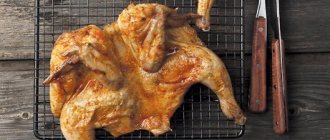Bird breeding always implies a constant increase in the number of livestock. Of course, you can purchase already grown chicks, but it is much more economical to use the incubation method. In this way, it is possible to obtain a sufficient number of chicks without unnecessary investments.
How many eggs to place under the hen?
However, this is only if natural incubation can be used. After all, then you can seriously save on the purchase of the equipment itself, the cost of light and electricity. But few people know how many eggs to place under a hen , how to properly care for her and many other necessary subtleties. Therefore, first you need to familiarize yourself with the most basic points of this issue. Only after this can you begin the interesting process.
Advantages and disadvantages of breeding chickens with whooping hens
Hatching eggs by a brood hen is an ideal way to raise poultry. Main advantages:
- The owner does not need to supervise the process, turn the eggs, or control the temperature.
- Kvochka, a hen who likes to incubate eggs, will take care of the chickens herself. She will teach the chicks to drink, eat, and protect them from threats and bad weather.
- Instinct will tell the hen how to keep her babies warm. She will help them hatch, break the shell if necessary.
- The hen will roll out the non-viable eggs from the nest.
- There is no need to spend money on buying an incubator.
Hen and chicks
Pay attention! When sitting in the nest, at first the hen does not distinguish lifeless eggs from those in which embryos develop. It sits on everything and does not allow other chickens to approach its favorite place.
There are reasons why owners breed birds in an incubator:
- A quonka can sit on one and a half dozen eggs, no more, so that all are covered with feathers. A larger quantity can be placed in the incubator.
- The eggs are collected in advance, and the hen must be placed in the nest at the same time.
- Sometimes quons inadvertently crush eggs and chicks.
- The future brood needs to have a separate walking area fenced off, as the hens become belligerent towards anyone who approaches.
Considering the pros and cons of raising chicks naturally, it becomes clear that it is easier for the owner of a small chicken coop to use a hen to hatch chicks. On large farms, it is more convenient to breed poultry in an incubator.
Controlling the development of the chick in the egg
If desired, the poultry farmer monitors the development of the chick during the incubation period. This is done using an ovoscope. This device is easy to make at home. To do this, an oval hole is cut in a small cardboard box onto which the egg is placed. The reflector of a table lamp is inserted into the drawer from below. When the lamp is turned on, the egg is translucent and with a certain skill you can assess its condition. Control is carried out after every 6 days:
- 1. After the first period, unfertilized eggs can be detected. When examined, they are light, but there is no circulatory system. If during this time the embryo began to develop, but died, then the rudiments of the circulatory system in the form of a ring will be discovered. Such eggs are removed so that the hen does not waste her strength on them.
- 2. After the second period, you can find that in healthy embryos the egg is light in color and a complete network of blood vessels is visible. They stretch along the entire length of the egg from the blunt end to the sharp one. If the embryo is visible as a dark spot and there are no blood vessels, this means that the embryo has died.
- 3. On the third final viewing, you can detect the embryo itself and its movements in the egg. An egg that is dark when exposed to light and lack of movement indicates its death.
The best brood hens by breed
Not every hen can become a hen, since not all breeds of birds retain their maternal intuition. But there are chickens that like to sit on eggs and raise chicks.
Kuchin anniversary
A long-known breed. Farmers often purchase Kuchin Jubilee for the purpose of hatching chickens. At least 90% of the chicks are hatched from under the hen. The appearance of the chickens is majestic. The bird is viable and can easily winter in cold weather. She produces 2 hundred eggs per year.
Kuchin Jubilee hen and chicks
Cochin
There are few breeders who have Cochin chickens, since many people keep the Asian breed as an ornamental one. This large bird:
- has strong immunity to diseases;
- quickly adapts to new conditions;
- lays eggs in an unheated chicken coop in winter.
Cochin chickens have thick plumage.
There are lush feathers on the legs, which is why the chicken does not freeze in the cold.
Laying hens produce no more than one hundred light brown eggs per year. The breed is prized for the way the hen hatches her chicks.
Welsumer
The breed was bred in the village of Velsum (Holland), hence the name. Birds are suitable for breeding in places with frosty winters. Laying hens produce up to 2 hundred eggs per year. Welsumer chickens are prized for their friendly nature and brown spotted eggs. According to poultry farmers, no other chickens have such tasty eggs.
The chickens have a decent appearance and productive performance
Welzumer does not have the instinct of a hen: the chicks are hatched in an incubator or a hen of a different breed is placed on them.
Brahma
This chicken has a decorative appearance, but is also easy to care for. During the year, chickens produce 100-120 eggs, larger than those of other breeds. According to reviews from poultry farmers, a more caring hen than Brama cannot be found.
Due to the lush plumage even on the legs, the bird is suitable for breeding in areas with cold winters; in the south it will be hot
Feeding the chickens
Chicks need to be given special attention; it is important to monitor how they gain weight. If necessary, the young animals are fed. Some cubs are developmentally delayed and may have no appetite. To improve the situation, you need to separate them and place them in larger and warmer cages. Frail individuals should be fed regularly.
Peculiarities:
- The optimal complementary food after hatching is a boiled egg. You need very little of it (1 per 30 chickens).
- Later, you can give feed (starter), rich in microelements and vitamins necessary for the normal development of young animals. Old food cannot be used.
- The hen needs to try the food first, and she will make certain sounds, inviting the hatchling to eat.
Babies need to be kept at a temperature of +28 degrees. Young animals can be released for chicken only when hatching ends. You can place under the hen not only the chicks she hatched, but also the brood from the incubator. It is better to do this during the evening feeding.
It is better to give chickens crushed food, but it is necessary to separate small fractions that the chicks do not eat. If there is nothing to grind the grain with, you need to add vitamins. It is better to use additives that need to be dissolved in water; their dosage is easier to calculate.
To prevent the food from staining the plumage and paws of the chicks, a small amount of semolina or corn-based flour is added to it.
The first feeding of chickens is carried out immediately after transplantation into a box or box.
On the first day of life, a crushed boiled egg is given. Subsequently, this product is mixed with powdered oatmeal and diluted with fresh cottage cheese. This food contains vitamins and microelements necessary for full development.
On the second day, finely chopped greens are added to the eggs - nettles, alfalfa, clover or dandelions. Then finely chopped root vegetables are introduced step by step.
On the second day, finely chopped greens are added to the eggs - nettles, alfalfa, clover or dandelions. Then finely chopped root vegetables are introduced step by step.
The individual must also have external characteristics:
- the young animals stand firmly on their feet;
- the head is of medium size;
- eyes are clean,
- shine may be present;
- the beak is thick and short;
- the wings are pressed tightly to the body.
How to determine if a chicken will hatch eggs well
Formally, the birds in the chicken coop are divided into groups:
- The quons themselves sit in the nest, incubate the eggs, sometimes without leaving the place to eat and drink. Then the chicks are carefully looked after.
- Irresponsible whores with weak maternal instincts. After spending a short time in the nest, they leave and forget to return.
- Chickens that lack the brooding instinct. Such birds are obtained mainly as a result of mixed breeding in large industrial farms. They are not forced to hatch chickens, but use an incubator.
To find out if there is a hen in the chicken coop, you need to observe the bird for 5-7 days.
Features of the behavior of a hen ready to hatch chicks:
- stays in the nest for a long time;
- behaves restlessly, sits down here and there;
- constantly clucks loudly;
- plucks feathers on the chest, covers the favorite place;
- fluffs up the tail and wings;
- the bird is chased by other chickens and a rooster (she is like an outcast).
The quonka sits on the eggs when egg-laying ends.
Note! It’s easy to notice that the chicken has stopped laying eggs. It fades from red to almost colorless.
Basic rules for raising turkeys
The first rule of keeping turkeys is to keep turkeys separate from the main flock of other poultry. It often happens that chickens and many waterfowl are hidden carriers of pathogenic microorganisms, and they themselves may not get sick, but for turkeys these infections can be dangerous.
Therefore, it is advisable to allocate an area for keeping turkeys in the corner opposite the chicken coop.
Another indisputable rule is to purchase chicks for further breeding only from trusted sellers or poultry farms. In this case, there is a guarantee of getting healthy young animals that will grow and develop without any problems.
Another guaranteed way to obtain healthy birds for further rearing is to purchase eggs for incubation and hatch them at home in an incubator. In this case, the chicks will hatch healthy and grow without disease. Only then will almost all of the young survive.
The third rule of raising turkey poults is to adhere to a certain diet for turkey poults from birth to three months of age. Turkey poults are raised for meat until they are about six months old. Moreover, the young animals begin to gain most of their weight three months after birth.
But in the first 60 days after birth, turkey poults do not grow very slowly. This is a physiological feature of these birds. Therefore, you should not experiment with nutrition during this period. Do not introduce any eggs, cottage cheese, grass, vitamins or medicines. It is enough to feed turkey poults with starter feed from the first days of life. By the way, also put a drinking bowl with clean water.
How to choose eggs for a brood hen
Once a brood hen has been selected, you need to place eggs under it. The quonka will roll a few pieces into the nest itself.
In order for healthy chickens to hatch, you need to choose only suitable ones:
- without visible damage or defects;
- regular shape (one end is sharp, the other is blunt);
- no contamination;
- a medium-sized egg (a large one can have 2 yolks);
- presence of a small air chamber, yolk in the middle.
The air chamber is visible when examined with an ovoscope. If it is not there, check with a regular flashlight (without glass) or over a table lamp.
Under an ovoscope they look at the color of the egg.
If the egg is light-colored or has roughness on the shell (marbled), it is not suitable for brooding. There are eggs (this can be seen through candling) with large dark spots - signs of the presence of mold colonies. Naturally, these are not suitable for hatching.
Note! Seven-day-old eggs are suitable for incubation. A freshly laid egg, like yesterday's egg, is not added.
Conditions of detention
After drying the chicken and transplanting it into a dry container, transfer it to a warm room together with the hen:
A hen with a brood will always stay somewhat aloof from the other birds, keeping a close eye on both the chickens and objects that, from her point of view, are dangerous.
After the chicks have returned to their mother, the entire family is placed in a warm, draft-free poultry house. The floor temperature in it should not be less than +22 ° C (it is advisable to arrange bedding).
Preparing the mother hen
They choose a bird with a brooding instinct and prepare a nest for it in a secluded place so that the hen is not disturbed by other inhabitants of the chicken coop. Further actions:
- They don’t plant the hen right away. First you need to be 100% sure that the cherry salmon is ready.
- The decoys are placed in the equipped nest. They are made of wood and foam in the shape of an egg. Experienced poultry farmers advise using ordinary pebble stones.
- The bird should sit on the decoys for 5-7 days. It happens that a black chickweed will sit for 2 days, get up and leave.
- If the hen does not leave the nest after a week, she is ready to hatch.
On the forms, novice poultry farmers often ask the question of what to do next when the chicken has sat on the eggs. In the dark, the decoys are carefully removed from under the chicken and the prepared eggs are placed. Sometimes more than one hen sits, then several nests are built. They are separated from each other so that the birds do not see each other.
Note! Pebble stones used as decoys can be found on the river bank. With their help, they can also wean younger hens from laying eggs anywhere.
IT'S TIME TO PLANT THE BINS
excerpts from the book by I. Gorbunova and L. Isachenko “Home Farm Month by Month”, prepared for publication
Experienced poultry farmers advise: before you start using an incubator, it would be nice to get the hang of hatching young animals under brood hens. They will tell you a lot and warn you about mistakes. You just need to be more attentive to their behavior.
For poultry farmers, the natural hatching of young animals gives special pleasure. It’s so interesting to watch the hen in the nest, her behavior, “conversations” with the brood, which is still sitting inside the egg. And how much joy there is when the babies hatch!
The females that have decided to become hens cluck as if they are telling their owners: “It’s time, it’s time, plant it.” A good black cherry has a calm character; it must be well-fed, because during incubation it loses a sixth of its weight.
Among the birds bred in poultry farms and ubiquitous in private farms, it is difficult to find a brood hen. More than other chickens, simple village chickens strive to incubate. Assiduous hens and turkeys. Under them you can raise not only turkey poults or chickens, but also goslings and ducklings. Even turkeys incubate. They are placed in a nest on egg linings, covered with a basket and left in a quiet place. After two days, the basket is removed, but the turkey no longer flies from the nest, and then eggs intended for hatching are placed under it.
The bird, still unknown as a hen, is first placed on test eggs. If she sits calmly, tightly in the nest and only comes out to walk, peck food and drink water, and remains in the nest at night, then you can safely lay eggs for hatching. The nest should be spacious: for a chicken - 40-50 cm in length, width and height, for turkeys, geese and ducks - more
Eggs intended for incubation are not left in nests; they are removed immediately after laying. In order not to erase the surface layer of the shell, take it carefully with clean fingers, and not with the whole hand. In the room where the hens are located, food and water are placed. Choughs themselves come out to peck, drink, and stretch their bones. But some people are so diligent that they don’t even look in the direction of the feeding trough. They are removed from the nest and forced to eat. Make sure that there is clean air in the brooding chamber, otherwise ammonia and other gases harmful to the embryo will penetrate through the pores of the shell.
The food is the same as before. However, it doesn’t hurt to watch the bird’s digestion. Is her droppings large but not runny? That means she's healthy. If it’s the other way around, then the owner needs to put thicker, crumbly mash in the feeder or replace it with grain for a while, preferably steamed oats.
From time to time, when black whales go off to eat food, they inspect the nests. It happens that an accidentally broken egg is found in one of them - it must be removed.
Different poultry have different incubation periods. A chicken breeds in 21 days, a turkey in 29, a duck in 28, and a goose in 30 days. However, these dates are not absolutely accurate. It happens that chickens hatch on the 19-20th day, but sometimes they are delayed, and the brood appears on the 23rd or 24th day. The fact is that chicks can hatch from newly laid eggs earlier than from lying eggs. Both the weather (cold and hot) and the zeal of the chough matter.
The general breeding rules for all types of poultry are approximately the same, but how to act in a specific situation? If a good hen appears on the farm, take care of her. Some poultry farmers band their best hen - attach a light wire to the leg so as not to accidentally kill it. Eggs are placed under it twice in the spring, and the chicken hatches them all. A box of hay is placed in a secluded place.
When eggs are selected for hatching, the date and month are written on them with a pen. If the same hen is planted a second time, then after the shell is removed from the nest, 11-13 eggs are laid again. The squeaks of the chicks from the previous brood should not reach her, otherwise they will not sit.
After the hatched chicks have dried, they are placed in a box and placed in a warm place. The last two or three chicks are allowed to dry under the feathers of the hen. Then she and her brood are transferred from the nest to the floor and all the babies are allowed to approach her. The hen immediately begins to teach them to peck, and they pick up small, small stones to grind food into their crops. The yolk reserve for a newborn chick is enough for two days, during which time it can do without feeding. If you immediately start feeding chopped eggs and something else, most of the chicks get diarrhea, and then, lo and behold, they die. When feeding on the second or third day, there is practically no waste at first.
Do chickens need a rooster to lay eggs? This question is sometimes asked by poultry farmers. Without a rooster, hens lay eggs anyway, and unfertilized eggs do not spoil so quickly and withstand transportation better, but with a rooster, egg laying is higher. Experiments have shown that pullets kept with roosters have heavier ovaries.
In April, you need to pay special attention to laying hens. The best of them lay eggs almost every day. Those that are worse - in a day or two, and the bad ones - after three days on the fourth. If you palpate the chickens in the morning, as soon as they fly off the roost, you can tell in advance whether a particular hen has an egg or not. Record the number of eggs obtained from each hen. In this way, the best chickens can be identified in three to four days. Some poultry farmers do not accept the technique of probing chickens; they believe that this creates a commotion - the laying hens are nervous. That is why they propose to study the external characteristics of the eggs from each hen (after collecting them from the nest, immediately write down which hens they came from), by which you can find out which bird the egg belongs to.
Some chickens lay a lot of eggs, but they are small. These laying hens should be mated with a rooster descended from a large-egg hen. In addition, pullets lay small eggs. Young animals are not bred from sick birds.
Turkeys, like geese, sit down to incubate, laying 11 to 17 eggs. However, geese of certain breeds, for example, Kuban, produce much more eggs. In ducks, egg laying lasts longer. Muskies produce from 20 to 80 eggs per season. It has been noticed that if the eggs laid by it are constantly taken from the nest of a laying bird, then it will lay more of them before incubation. However, musk ducks easily notice the loss and sometimes abandon their nest and fly somewhere outside the house. This also needs to be taken into account.
A female who wants to incubate can be identified by the following characteristics: she avoids the male and remains in the nest longer than others after laying the egg. Well, chickens, as you know, cluck.
Every day the hen strives more and more for the nest and finally stays in it for the night. This is where you need to lay eggs for hatching. She gets used to her new role more easily if she sits in the same place where she was rushing, especially if she has already bred offspring here. The hen will diligently sit on the eggs. Still, it is advisable to plant it in another, quieter place so that it is not disturbed by other birds. However, new difficulties arise here. In an unfamiliar place, the hen sometimes does not want to sit, she may drop her eggs and leave. This especially often happens with a bird that is accustomed to roaming freely. That is why, in order not to risk breeding eggs, they are planted with trial eggs.
If several hens are planted in the spring, then you need to provide a warm and dry room for them. An attic or barn would be good for this. In a cold room, incubation is less successful, because hatching usually begins in March, when the air temperature is not yet sufficient for the chicken or turkey to sit freely on the eggs.
In one of the corners of the “hen” compartment they make or place a ready-made nest, in another corner they fence off part of the floor with a board for sand and ash, in which the hen could bathe, and in the third they place dishes with water and food. The bottom of the nest is lined with some soft bedding, preferably soft hay. It is helpful to place a thin layer of soft feathers on top of this. The litter is laid so that a shallow hole is formed in the nest, where the eggs are laid.
As many eggs are placed under the hen as she can cover with her body and wings. For a chicken, this is 13-15 eggs, but if the hen is a large breed (Brahma, Cochin, etc.), they lay more - up to 17 eggs. When laying eggs, the air temperature is also taken into account. In cold weather, it is more difficult for the hen to heat a larger number of eggs, and the hatch may be worse. About 15 eggs are also placed under a duck, all the eggs that were laid by them before incubation are placed under a turkey and goose, and up to 38 eggs for chicken and duck eggs. According to poultry farmers, it is better to breed turkey poults under chickens, and not under the turkeys themselves. Chickens begin to cluck earlier and are more careful during incubation. Seven to nine turkey eggs are placed under each hen.
The success of incubation also depends on which eggs to choose for hatching. The main thing is that they must be fresh. The fresher the better. Those lying there for more than three weeks are considered unreliable. However, poultry farmers make exceptions to this rule. Before incubation begins, they keep the eggs in a dark place at a temperature of 5-15 degrees. Every day they turn the other side up. You can keep it in cardboard (store) packaging. In order not to touch the eggs with your hands and not to contaminate them with microbes, put a second package on top and tip it into it very carefully.
For the hen, single-caliber eggs are selected, of a regular, “egg” shape, with a completely clean shell, without calcareous growths, irregularities and cracks. Eggs that are too small, too round, pointed and too large are rejected. These most often turn out to be unfertilized or chicks with some abnormalities are hatched from them. For example, small eggs sometimes have a very small yolk, which is not enough for good nutrition of the chick.
There is a lot of talk among poultry farmers about the possibility of recognizing the fertilization of eggs. But most of these rumors are the fruit of unfounded imagination. The fertilization of an egg can only be determined under a microscope, but then it would have to be broken. However, the distinct outline of the puga is important when choosing eggs. The larger the space filled with air at the blunt end, the older the egg and vice versa. The distinctness of the puga indicates how uniform the density of the shell is.
Nests for birds of any kind must be arranged so that they are ventilated. To do this, they are placed on two boards. To create the necessary humidity, a piece of turf (harvested in the fall) or soft, clean rags is placed at the bottom of the nest under the bedding. During incubation, ducks love to bury themselves almost headlong into the litter, so their nest is generously lined with fluffy hay. It is better to place the hen in the nest in the evening. Then, according to poultry farmers, hatching will begin in the evening, which is more convenient for the owners than during the day when they are at work.
If the room is cold, it is advisable to heat it a little, that is, maintain normal room temperature. The room where the hens sit is often ventilated and cleaned daily. In this case, the hens are disturbed as little as possible, only the nests are inspected from time to time. Unintentionally broken eggs are removed, dirty litter is replaced with fresh one.
Nest construction
In order for the brood bird to quietly hatch the chicks, choose a place away from the inhabitants of the poultry house, warm, dry, where there is no draft.
Quote nest size:
- length - 30 cm;
- width - 30 cm;
- height - 30 cm.
The nest must have a roof, walls, and floor. The roof is made at an angle of 45° so that birds do not land on it and pollute it. Algorithm for further actions:
- A frame is made from a 40×20 block, sheathed with boards, plywood, OSB. Everything is whitewashed without fail.
- Attach a take-off bar no more than 15 cm wide so that the hen can lean on it when leaving the nest and when entering inside.
- A curtain is hung over the hole (entrance/exit). Kvochka loves to hatch chicks in dark conditions.
Experienced poultry farmers advise making movable nests, since they are easier to clean, repair, whiten, and move to another location.
Hang nests at a height of no more than 1 m
If the nests are installed above 1 m, then be sure to attach a ladder (ladder) to the take-off shelf, otherwise the chicken will not want to fly into a high nest. Then:
- A layer (2-3 cm) of dry leaves, peat, sawdust or sand is poured onto the bottom of the box. The main thing is that the material is dry. This is a drainage layer that absorbs the waste products of a sitting chough.
- Lay straw (last year's) or hay on top in a layer of 2-3 cm. Everything that the chicken excretes during incubation will fall through the straw, like through a net.
- To prevent the eggs from rolling out from under the hen, sides are made. Take 4-5 bunches of straw, twist and lay them, giving them the shape of a ring.
Previously, a mother hen often had a nest in a sieve or an old bucket.
On a note! Nests for chickens can be purchased in specialized stores, but they are expensive, and many models have not been tested in action. But you can make nests for chickens with your own hands.
Caring for chickens during hatching
It’s easy to provide complete care to your tussocks. A well-equipped nest is 90% success.
Rules for organizing a roost:
- a wooden box with an area of 55 by 35 cm is taken as a basis;
- the entrance is covered with a light cloth so that the chicken can easily enter and exit;
- the bottom is insulated with earth, a layer of 5 cm, and the top is covered with dry straw;
- A hole is dug in the center of the perch so that the eggs are constantly lying under the chough.
Rules for caring for hens:
- The nest is placed in the far corner of the chicken coop, isolated from extraneous noise and the presence of people. If 3-4 roosts are planned, then install partitions between them to prevent conflict situations between females.
- The female hen needs to leave the nest twice a day to eat and go for a short walk. If the chicken does not leave the roost, this should be done forcibly.
- When the hen is away, it is recommended to cover the perch with a thin blanket to prevent hypothermia.
- A drinking bowl, a feeder and a tray with ash are placed next to the nesting area.
- Baths made from the remains of burnt wood are useful in the fight against skin parasites.
- In winter, it is advisable to equip the house with a heating system, since the natural heat of the hen will not be enough.
How many eggs can you put under one chicken?
A hen can hatch up to one and a half dozen eggs, since the bird's plumage must cover all the eggs in the nest. On forums, poultry farmers write about cases when quons hatched 23-25 eggs. The hen can “hover” (as experienced poultry farmers say) not only chicken eggs, but also duck, goose, and turkey eggs.
Since the eggs of other birds are larger, the whooping whale will cover a smaller amount:
- 8-10 duck;
- 4-5 goose;
- 7-8 turkeys.
The number of eggs depends on their size and the size of the brood hen.
Condition assessment
During incubation, the eggs are inspected three times. Larger quantities are not recommended, as there is a risk of shell damage. It also negatively affects the emotional state of the hen and the embryo.
- The embryo is not yet visible, but blood vessels are already visible. If the chick has died, they become dark.
- Blood vessels envelop the light spot in the center. If the formation of the embryo does not proceed according to schedule, then the vessels do not completely cover the lateral space. The dead embryo, which is visible at this stage, looks like a small dark spot without blood vessels.
- The embryo is clearly visible upon examination: the outline of a neck is visible at the blunt end.
After each candling, rejected specimens are destroyed.
How to force it and is it possible to train a chicken
Many poultry farmers are categorically against the forced method of setting the hen to “hover” eggs. They believe that no matter how you cover the chicken, don’t lock it, if it doesn’t want to, it won’t sit: it will scatter the eggs and shit in the nest.
But there is an opinion that a chicken can be turned into a hen. To do this, choose a quiet place, hidden from other individuals, set up a nest in which the decoys are placed. The chicken is placed on them, the nest is locked or the bird is covered with a basket.
Chicken sits locked in a nest
Nothing threatens the health of the chough. The brooding instinct “wakes up” after 2-3 days. Then the basket is removed, and if the bird does not leave the nest, eggs are placed late in the evening and even at night for incubation.
Optimal quantity
When the chicken, which has a brooding instinct, has passed the test, material tested by an ovoscope is placed under it. How many eggs can be placed under a hen depends on the breed (size) - standard numbers are 12-15 pieces. Miniature chickens can place 10-12 pieces under them, large ones - 15-17 pieces. Chickens can also hatch eggs:
- turkeys – 7-11 pcs.;
- ducks – 7-11 pcs.;
- geese – 5-7 pcs.
It is better to put an even number - it is believed that in this case the hatching of young animals will be better. The hen is placed on the clutch in the evening - this reduces stress levels and allows the bird to get used to it faster.
3 days before this, the chicken is examined for the presence of parasites, and if necessary, treatment is carried out. She is also provided with balanced food.
You cannot add new specimens during the incubation process - after the chicks from the main batch appear, the hen will leave the nest.
Brood hens: how to care for them
In order for a hen to raise healthy and strong chickens, she must be provided with proper care:
- The temperature in the chicken coop where the black whale sits should not fall below 18 °C.
- If the quonka does not want to voluntarily leave the nest, it must be taken out and taken out for a walk for 15-20 minutes so that it can stretch its legs.
- There may also be droppings in the nest. It is removed and clean straw is laid down.
During the absence of the black cherry, the nest is covered with straw or a rag. They also remove droppings and take out eggs crushed by the bird due to negligence, if there are any. Some owners manage to illuminate the eggs with a flashlight. Discard if necessary.
Note! No other eggs are placed in exchange, since the hen, having discovered the substitution, may not sit in the nest.
Creating the necessary conditions for hatching chickens
A nest in a darkened corner of the poultry house or a separate room in which the hen willingly laid eggs is also suitable for breeding. But the hen also needs peace; overly curious neighbors can harm future chickens and make the hen nervous and behave aggressively:
- A box or cardboard box measuring at least 60 cm in length and 30-50 cm in width, with high sides to prevent eggs from accidentally rolling out.
- The bottom is covered with turf, leaves or straw.
- It is worth pouring sawdust or fresh hay on top.
- The hen herself lines the bottom with down and feathers.
- The room should be cool, dry, but not cold.
- Chickens must be provided with good ventilation and constant access to fresh air. If desired, the hen should calmly leave the nest and return freely.
A properly equipped place for breeding chickens in many ways becomes the key to successful breeding of offspring.
How to feed a hen
While the chicken is hatching eggs, she sometimes may not eat for 2-3 days; it is no coincidence that the chicken loses weight. Feeding Features:
- It is necessary to provide the quotation with food and drink. The water is changed to always be fresh.
- The hen is given food rich in vitamins and minerals, fresh grass or hay, and cut root vegetables.
Klusha gets up no more than 2 times a day to eat and drink. A week before planting, caring owners make sure that the future “mother” eats well, since she will need strength to sit on the eggs and then care for the offspring.
Features of different breeds of chickens
Some breeds of chickens were selected specifically for laying a large number of eggs - the so-called egg breeds. They are capable of producing up to 200 eggs per year or more, but in hens the brooding instinct is poorly developed.
Among the breeds popular in the CIS countries, several can be noted (including those prone to brooding):
Welzumer is the most popular species in small farms and farms. It is considered a mixed meat-egg breed, as it annually brings owners up to 180-190 large (60-65 g) eggs. Disadvantages: some hens have lost their brooding instinct, so you will have to select chickweeds in advance;
Breed Welsumer
Cochin is one of the largest and most flexible breeds. Decent egg production in the winter months, easy to find laying hens;
Brahma is a breed that is distinguished by its large size and weight. But birds grow rather slowly and are prone to obesity. Dark brams are considered good cows;
Brahma breed
Kuchinsky Jubilee is one of the most unpretentious and calm breeds popular in Russia. Egg production is also high, and most hens cope well with the functions of hens. After hatching, you can immediately determine the sex of the chick: roosters have lighter wings than the carcass, while hens have darker wings. Thanks to the large amount of fluff, the hen calmly hatches up to 14-15 eggs.
Kuchin anniversary
How long does a hen sit?
Chicks may not appear at the same time. Usually, chicks hatch from under the hen after 3 weeks - exactly as long as the hen sits on the eggs. There are chickens that emerge from the shell after 18-19 days.
The nest is watched for the first chicks. When the chick is dry, it is removed and kept in a brooder at an air temperature of at least +25... +30 °C.
Only after the last chick appears, all the babies are returned to the hen.
When to apply?
Before you think about how to place eggs under a hen, you need to figure out when is the best time to do this. Incorrect timing may cause the hatched offspring to die due to cold weather.
The optimal time is the first half of April. In this case, the chickens will hatch after 3 weeks, that is, in early May, and will have time to get stronger by autumn and develop good plumage by winter.
Important! Since the climate varies from region to region, please be aware of the weather conditions. Check the forecast and ensure that after the expected birth of the chicks there will be no prolonged cold, and especially frost.
Egg selection
The poultry farmer should carefully select eggs from the chicken coop to place under the selected mother.
Important! In order not to have any doubts about the suitability of the product for breeding chickens, you need to maintain the ratio of hens and cockerels in the poultry house. The norm is 1 male per 10 females. There are also exceptions (depending on breed characteristics).
There are a number of requirements for eggs for incubation:
- Their breeder must be healthy: timely vaccinated, treated for parasites, without signs of illness.
- The hen must reach puberty (age varies depending on age).
- Testicles undergoing lining must be fresh. They are considered as such if 6 days have not passed since their production. The temperature regime in the poultry house has a huge impact. Optimal indicator: from 15 to 20 degrees. Humidity about 75%.
- Broken and dirty ones are not used for lining.
- When choosing a size, focus on medium. Small ones do not guarantee correct formation; large ones often contain 2 yolks.
- For accurate information, eggs should be examined through an ovoscope. The presence of foreign inclusions is not allowed.
Hatching process
It is interesting to observe the unique process of the birth of babies. One can only marvel at the wisdom of nature, because caring for a mother hen’s chicks begins from the first days of incubation. The chicken accustoms the babies to the sounds of its voice and listens carefully to what is happening. She hears the first squeak, rolls the eggs that have begun to cool deeper under her, and helps make the first pricks on the weak chicks when they are born:
- 2-3 days before the chicks hatch, even a person can hear a soft squeak coming from under the shell. The chicken listens carefully to the sounds, clucks over each egg, and moves some.
- 1 day before the babies are born, the first cracks in the shell appear: the grown chicken tries to break through the hard shell with an egg tooth (a hard growth that falls off 2-3 days after the chick emerges).
- The cracks are increasing, a clear squeak and a soft knock of the beak on the shell are heard.
- 3-4 hours before pecking, a hole appears in the shell through which the beak can be seen.
- The hole quickly increases in size, and soon the head and legs with claws may emerge into it.
- Having completely destroyed the protective layer, the baby finds himself in the nest next to his mother, completely wet, and the hen gently pushes him under her.
This happens with almost every egg. Watching carefully, the chicken only sometimes helps weakened babies who cannot break the shell on their own
She may gently tap the shell several times or just once to help.
Having warmed and dried the chicks, the mother will show the little yellow lumps how to eat, drink, and where to look for food. This will not happen until the chicken is ready to move. There is no need to speed up this process either.
